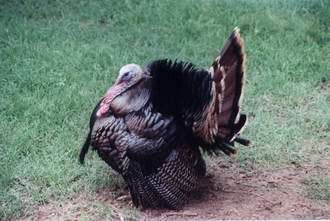Penn State offers tips to handle turkeys safely and keep the holiday pleasant

Low in fat and cholesterol, turkey is a healthy food choice for the holidays. But, if improperly handled, it can become a breeding ground for foodborne illness caused by bacteria.
"Salmonella bacteria sometimes are present in small numbers in all raw animal products, such as poultry, eggs, meat and dairy products," says Catherine Cutter, associate professor of food science in Penn State's College of Agricultural Sciences. "If properly handled and prepared, these foods are safe to eat."
Cutter says because bacteria are killed by heat, illness due to Salmonella and Campylobacter found on raw poultry can easily be prevented. She offers a few common-sense procedures for preparing turkey safely:
-- Thaw frozen turkeys in the refrigerator, not on the countertop. Harmful bacteria can multiply once the exterior of the bird reaches 45 degrees Fahrenheit. "Plan ahead to thaw the turkey in the refrigerator, allowing about 24 hours for each five pounds," Cutter says. "For example, a 10-pound bird will take about two days."
-- Cook stuffing in a separate pan. However, if you stuff your turkey, do it immediately before cooking. "If you put warm stuffing inside the turkey, then put the bird back into the refrigerator, you give bacteria a chance to grow," she says.
-- Never partially cook a turkey or other raw animal foods. Plan to cook the turkey in one continuous stretch until the meat is done. Always cook it at an oven temperature at or above 325 degrees Fahrenheit.
-- Use a meat thermometer. Cookbooks and labels only can estimate how long the bird will take to cook. "The only sure way to tell when the turkey is safe to eat is to insert a properly calibrated meat thermometer into the center of the breast," Cutter says. "The temperature should reach a minimum of 180 degrees Fahrenheit. If you are cooking a stuffed turkey, the center of the stuffing should reach at least 165 degrees Fahrenheit."
-- Avoid contaminating other foods with bacteria from raw poultry. "Cooks should wash their hands with soap and water immediately after handling raw turkey," says Cutter. "Cutting boards, utensils and dishes used to prepare the raw bird also should be thoroughly cleaned with warm soapy water and sanitized with one tablespoon of chlorine bleach per gallon of water before they come into contact with cooked turkey or other ready-to-eat foods, such as fresh vegetables."
-- Remember the two-hour rule -- don't let leftovers sit out on the table or countertop for more than two hours. After the turkey is served, leftover meat should be cut off and placed in shallow, covered containers and refrigerated immediately. Rapid, even cooling will help prevent bacterial growth.
-- Leftovers should be eaten or frozen within three to four days. Gravy and stuffing should be eaten within two days. Heat all leftovers to at least 165 degrees Fahrenheit before serving. Bring liquid leftovers, such as gravy, to a rolling boil.
The effects of foodborne illness due to Salmonella or Campylobacter may appear within a day or so after eating contaminated food. Symptoms include diarrhea, abdominal cramps, fever, nausea, vomiting, chills and headache.
In healthy adults, the symptoms may last up to three days. For children, the elderly and those whose immune systems aren't working properly, these pathogens, if left untreated, can result in dehydration and, in rare cases, death.
Source: Penn State


















